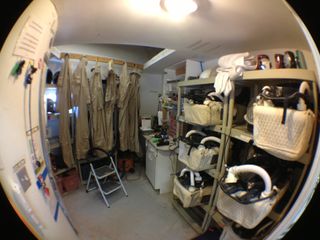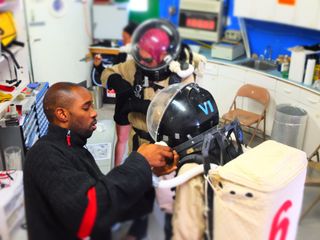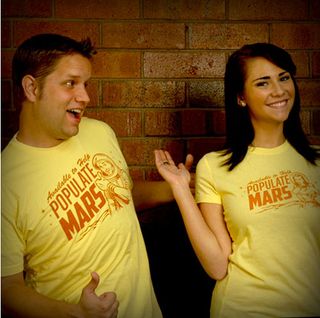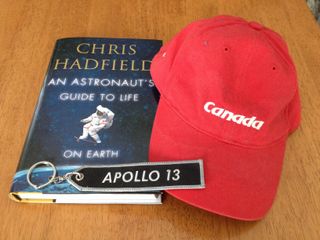Mock Mars Mission: How to Pack the Red Planet Way

OTTAWA, CANADA — I'll admit it: I've become that annoying friend and family member, just in time for the busy holiday season. While the people I know are preoccupied with Christmas and New Year's events, I'm making constant requests to borrow things from them.
"Can I nab your warm sleeping bag?" I said to a friend who then had to make a special trip to my place with her precious cargo in the car.
"Is it okay if I take your DSLR — and can you show me how to make videos with it?" I asked a long-suffering family member who, despite a punishing schedule, is always being harassed for tech support.
I'll have to think of ways to pay them back. Right now, though, I'm just too busy packing. I'm about to spend two weeks in the Utah desert on a mock Mars mission, unable to buy even a toothbrush there to get me through the days. I, along with the rest of a University of North Dakota-led crew, will be onsite at the Mars Desert Research Station (MDRS) starting Jan. 4. [The 9 Coolest Mock Space Missions]

Packing for Mars
The Mars Society has more than a decade of experience in running these missions, so they provide each crew member with a detailed packing list. The list includes amusing asides: clothing for 15 days should be okay for "much re-wearing," and I'll likely want pajamas to sleep in, as walking to the bathroom in the morning involves facing "a throng of crew members."
If you can imagine packing for a two-week trip in a cabin, that's essentially what we're doing in the Utah desert. The list includes standard items like clothing, toiletries, outdoor gear, a sleeping bag and a flashlight. Because we're doing science, however, there are other things to consider. Everyone needs to have a personal laptop. Scientists must also bring items such as GPS units, rock hammers and topographic maps.
Get the Space.com Newsletter
Breaking space news, the latest updates on rocket launches, skywatching events and more!
We also have to take note of restricted items. Firearms and alcohol are absolute no-no's, and cologne isn't allowed, either, because some people have scent sensitivities. We are permitted to bring our own food onsite this season, so I'll likely bring some of my Christmas chocolate stash along. To share, of course.

No urine jars required
The list I'm reading today has changed quite a bit over the years. I'm supposed to bring hiking boots for simulated spacewalks, for example. Previous crews were allowed to use shared footwear, but that became a problem, MDRS Director Shannon Rupert told SPACE.com.
"For years and years we actually had boots that the crews would use when they went out, and we finally did away with them. It gets kind of disgusting to put your foot in someone else's boot," she said.

Fortunately for our crew, going to the bathroom is a pretty easy experience — just a standard flush toilet, nothing to worry about unless we put something unusual in there. Past crews had to bring their own jars and put urine in a funnel on the wall for a composting toilet. That item is now gone.
On Mars, "you wouldn't have to worry about where you're going to have to bury the compost," Rupert explained of the change. "A composting toilet is silly."
Personal items

I've limited myself to one suitcase for this trip, which means that there won't be a lot of space left over for personal items. I don't mind, however, because that's how it is in space. Like an astronaut preparing for a mission, I must make sure everything I lug from Ottawa to Utah is worth the weight and trouble.
As a Canadian, I want to honor our astronaut corps in a couple of ways. I'm bringing along a copy of Chris Hadfield's "An Astronaut's Guide to Life on Earth" (Little, Brown and Company, 2013), which should also give me tips on how to behave in close quarters.
I also have a special "Canada" baseball cap that marks one of Canadian astronaut Steve MacLean's flights, STS-115 in 2006. I hope the red color will keep my head looking spiffy on those inevitable bad hair days; I'm only allowed to shower once, quickly, every two days due to restricted water on site.
Perhaps the most meaningful item will be a small keychain that says "Apollo 13" on one side and "Failure Is Not an Option" on the other, a quote from the film based on the mission. I was a young teenager the first time I saw that film, and it sparked my interest in space. Nearly 20 years later, I can't believe how that one movie eventually rocketed me to this simulated Mars mission.
Elizabeth Howell will do a two-week simulation at the Mars Society's Mars Desert Research Station from Jan. 4 to 19. Have a burning question about the mission or a picture you really would like to see from the site? E-mail contact@elizabethhowell.ca for the chance to get your question answered in a future story.
Follow Elizabeth Howell @howellspace, or SPACE.com @Spacedotcom. We're also on Facebook and Google+. Original article on SPACE.com.
Join our Space Forums to keep talking space on the latest missions, night sky and more! And if you have a news tip, correction or comment, let us know at: community@space.com.

Elizabeth Howell (she/her), Ph.D., is a staff writer in the spaceflight channel since 2022 covering diversity, education and gaming as well. She was contributing writer for Space.com for 10 years before joining full-time. Elizabeth's reporting includes multiple exclusives with the White House and Office of the Vice-President of the United States, an exclusive conversation with aspiring space tourist (and NSYNC bassist) Lance Bass, speaking several times with the International Space Station, witnessing five human spaceflight launches on two continents, flying parabolic, working inside a spacesuit, and participating in a simulated Mars mission. Her latest book, "Why Am I Taller?", is co-written with astronaut Dave Williams. Elizabeth holds a Ph.D. and M.Sc. in Space Studies from the University of North Dakota, a Bachelor of Journalism from Canada's Carleton University and a Bachelor of History from Canada's Athabasca University. Elizabeth is also a post-secondary instructor in communications and science at several institutions since 2015; her experience includes developing and teaching an astronomy course at Canada's Algonquin College (with Indigenous content as well) to more than 1,000 students since 2020. Elizabeth first got interested in space after watching the movie Apollo 13 in 1996, and still wants to be an astronaut someday. Mastodon: https://qoto.org/@howellspace
